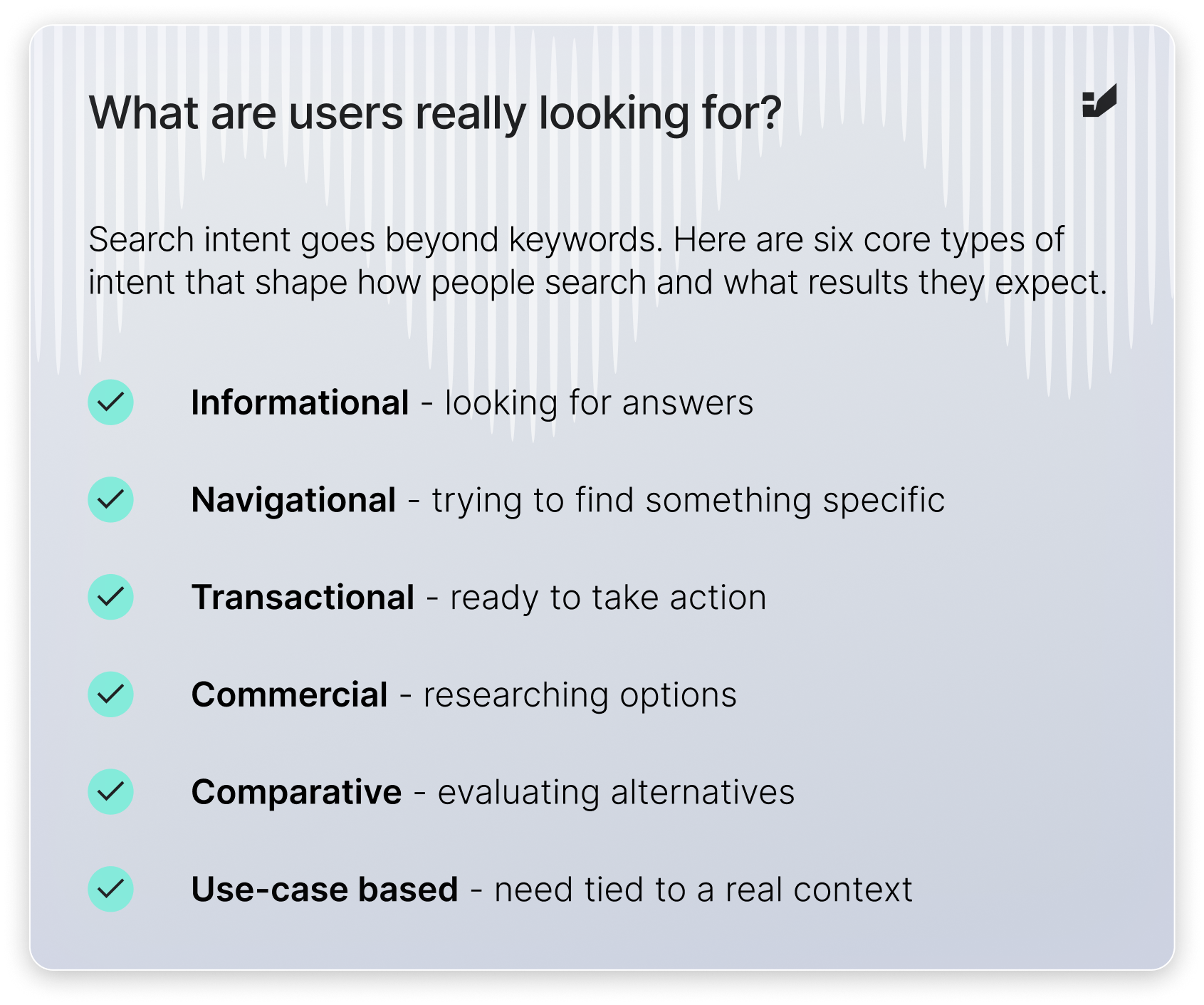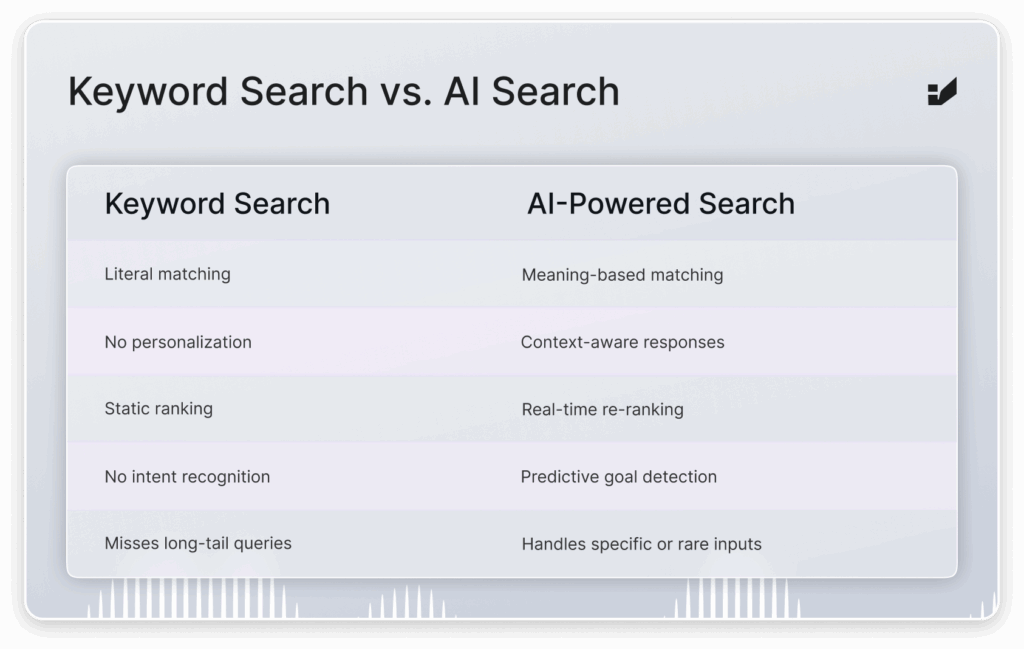Intent-based search: why AI understands customers better than keywords
Search engines today have a tough job. Queries are getting more complex, and natural language is often unclear. Traditional keyword-based systems often fall short, especially when context and user intent are more important than exact phrasing.

To address this, new systems are being developed around semantic search and natural language processing (NLP). Powered by large language models (LLMs), they focus on the goal behind a query instead of just the words. This shift helps deliver results that feel more accurate and genuinely useful.
Types of search intent
Classifying search intent is a key part of how modern AI search systems work. It’s about understanding what the user wants to achieve with their query. Getting this right is crucial for matching content with what people are looking for.

When queries are correctly linked to these intent types, results can be more relevant and better tailored to each user. Large language models are also getting better at spotting queries that mix more than one intent – for example, Is product X worth buying and where’s the cheapest place to get it? Understanding this kind of complexity helps semantic search work more effectively.
Key technological components
Intent-based search relies on a solid technical setup that can understand both the meaning behind queries and the context of the user. Several elements work together to make this possible.
- Natural Language Processing/Understanding (NLP/NLU) – for interpreting natural language queries, identifying syntax, semantics, and entities.
- Semantic Embeddings (semantic vectorization) – transform words and phrases into vector representations that capture contextual meaning.
- Retriever–Ranker Mechanisms (dense retrieval and ranking) – retrieve and prioritize the most relevant results based on semantic similarity.
- Query Rewriting Systems – improve system understanding by correcting or rephrasing user queries.
- Large Language Models (LLMs) – support context interpretation, intent classification, and generation of suggestions or alternative responses. LLMs serve as a central component for many of these functions.
There are also supporting tools like named entity recognition (NER), sentiment analysis, query classification, and hybrid search engines that mix traditional keyword matching with vector-based methods.

How AI interprets intent
Understanding intent isn’t just about reading the words in a query. AI-powered search systems use a mix of techniques to figure out what users are looking for, even if they don’t say it directly.
Semantic query interpretation
Thanks to semantic embeddings and large language models, search systems can make sense of queries without needing exact keyword matches. They pick up on synonyms, rephrased questions, and related meanings, which helps return better results for casual, vague, or more complex searches.
Context-aware personalization
Search engines use data like location, time, device type, and past activity to adjust results to match the user’s situation. This makes results more relevant without losing the core meaning of the query.
Real-Time Re-Ranking
By tracking how users interact with results – what they click, how long they stay, whether they return – AI systems can adjust the order of results on the fly. Machine learning loops use this behavior to fine-tune future searches based on current intent patterns.
Benefits of understanding intent
The ability to accurately recognize user intent directly improves search quality, user experience, and interaction efficiency. Intent-driven systems offer several key benefits:
- Higher result relevance by semantically aligning content with actual user needs.
- Shorter conversion paths by matching results to the user’s decision-making stage.
- Reduced cognitive frustration from irrelevant or generic search outcomes.
- Increased engagement and retention through relevant suggestions and contextual prompts.
- Search interface personalization based on behavioral data and intent profiles.
- Support for conversational interfaces (voice assistants, AI chatbots) in handling unstructured or multi-step queries.
As a result, intent-driven systems enhance both the effectiveness and usability of content exploration environments.

Why AI outperforms keyword-based search
Traditional keyword-based search is limited to simple string matching, which fails to capture the user’s real needs. AI – particularly modern language models – offers a new standard by understanding language more like a human. Key differences include:
- Literal matching vs. meaning comprehension:
Keyword-based systems ignore synonyms, paraphrasing, and context. AI analyzes query meaning using semantic embeddings and NLP, delivering relevant answers to even vague or unconventional queries. - No personalization vs. contextual relevance:
Traditional search treats every query in isolation. AI considers user context – location, search history, time of day, preferences – to tailor results. - Poor long-tail query performance vs. semantic generalization:
Rare or specific queries may return no results with keyword matching. AI can identify semantically similar content and provide accurate answers even for highly specific queries. - Static ranking vs. dynamic adaptation:
Keyword search uses fixed rules for ranking. AI allows dynamic result ranking based on user behavior (e.g., clicks, time on page, repeat searches). - No intent recognition vs. goal prediction:
Keyword-based systems don’t understand why a query is made. AI can classify intent (informational, transactional, etc.) and deliver results aligned with user goals, not just query text.
AI limitations and challenges
Despite their capabilities, AI-powered search systems – especially those based on LLMs – face several technical and operational challenges:
- Implementation complexity and resource demands:
Deploying intent-based systems requires substantial computing power, infrastructure, and training data. LLMs need ongoing tuning, version control, and low-latency inference environments, posing a barrier for resource-constrained organizations. - Query ambiguity and layered intent:
Many queries are vague or ambiguous. Mixed or evolving intents complicate classification, even with advanced NLP. - Maintaining quality, transparency, and oversight:
AI systems require constant monitoring, validation, and adaptation (model drift). It’s also crucial to manage risks such as system errors, algorithmic bias, and ensure explainability, especially in regulated or high-risk environments.
Future directions of intent-based search
Intent-based search is evolving toward greater flexibility, deeper context understanding, and integration with multimodal data. Key future trends include:
- Conversational AI and voice-first interfaces – enabling natural dialog-based queries.
- Integration with recommendation systems – predicting intent and offering suggestions even before a query is typed.
- Handling multi-step and long-form queries – LLM advancements help manage semantically layered inputs.
- Zero-query search – anticipating needs through behavioral and contextual signals.
- Multimodal query processing – combining text, images, and audio for richer intent interpretation.
- Dynamic adaptive interfaces – personalizing the search UI in real-time based on user profile and session context.
Search systems are becoming more predictive and user-friendly thanks to advances in architectures like retrieval-augmented generation (RAG) and the growing use of fine-tuned language models.

Key elements of effective intent-based search
To ensure success, an intent-based search system should incorporate the following:
- Intent–response mapping – matching content strategies to user decision stages.
- Use of contextual and behavioral data – building dynamic user profiles to enhance personalization.
- Structured content modeling – using standardized descriptions, tags, and taxonomies.
- Transparent ranking mechanisms – supporting quality control and information policy compliance.
- User feedback loops – automating result optimization based on user behavior.
- Editorial overrides (human-in-the-loop) – especially in sensitive areas (e.g., health, finance, law).
Effectiveness depends not only on technology but also on input data quality, information architecture consistency, and tight integration between semantic and content layers. Without this, even advanced AI may fail to deliver relevant results.
It’s time to rethink search
Search is no longer just about matching keywords. With the help of large language models, semantic embeddings, and data on user behavior, modern systems can get closer to what people want, even if they don’t say it directly.
Unlike older search engines, intent-based systems take context into account. They recognize where someone is in their decision-making process and can handle queries with more than one goal. This makes the results feel more relevant and more personal.
For companies, this shift means faster user journeys, better conversion rates, and a more useful experience overall. Moving beyond keywords isn’t just an upgrade – it’s becoming a must.


